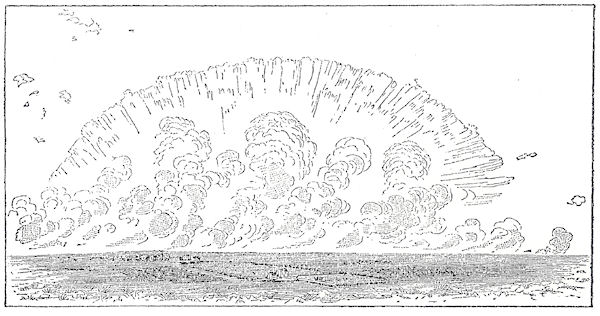Appearance of the cyclone cloud at Rochester, Minn., 1883.
On Tuesday, Aug. 21, I left Minneapolis [on the Minneapolis & St. Louis Railroad] at three o’clock in the afternoon for Albert Lea, Io [likely meant Minnesota].
Late in the afternoon my attention was attracted to a remarkable storm-cloud that lay along the eastern horizon. As the sun grew low in the west, this cloud assumed most extraordinary proportions and colors; so much so, that it attracted almost universal attention. A strange, fan-like sheet of yellowish cloud, with broken but decided margin, rose above the centre of the storm like a great halo. It did not seem to stand in a vertical position, but projected above, toward the west, giving the effect of a huge funnel, viewed from below, on the exterior surface of which the descending sun cast shadows, and brought out a sort of radiate ribbed structure.

Beneath this was a great cluster of swelling cumulus ‘thunder-heads,’ whose bases were hidden by the horizon. Three of these, higher than the others, rose vertically from the centre of the mass; their magnificent fleece-like heads entering and apparently penetrating the yellow halo. These, especially the middle and largest one, glowed brilliantly in the strong sunlight, and cast long shadows down the inclined under-surface of the halo.
Encircling this brilliant mass were a number of enormous ‘thunder-heads’ of a most murky and forbidding appearance, that stood upright, like so many pillars of dense smoke. These upright clouds inclined a little to the east or south-east, indicating a movement in that direction.
There was a remarkable stability about the whole mass of clouds, and at sunset the effect was grand in the extreme. The sky about was clear, with the exception of isolated masses of cumulus-cloud.
I made a small pencil-sketch of the cloud-forms, with notes of color, and, since my return to Washington, have made a drawing in color.
I estimated that the cloud was from forty to fifty miles east of the railway, and, on studying the map carefully, became convinced that this was the cloud attending the great cyclone at Rochester. My attention was not called to the cloud until after five o’clock, at which time it was directly east of me, at Wilton [in Waseca County, no longer a town]. As the course of the cyclone was a little to the north of east, the movement was directly from me when the sketch was made.
The peculiar form of the halo, whether fan or funnel shaped, was doubtless, in a measure, the result of the movements of the storm-currents.
W. H. Holmes.
Geological survey, Washington.
Source:
Science
Volume III, Number 58, March 14, 1884
Page 304